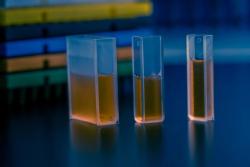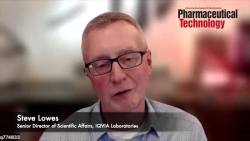
OR WAIT null SECS
- About Us
- Advertise
- Contact Us
- Editorial Info
- Editorial Advisory Board
- Do Not Sell My Personal Information
- Privacy Policy
- Terms and Conditions
© 2025 MJH Life Sciences™ , Pharmaceutical Technology - Pharma News and Development Insights. All rights reserved.
How to Monitor HPMC Concentration Through Conductivity Measurement
The authors demonstrate that a proper measure of HPMC solution concentration is its electrical conductivity rather than its viscosity.
Submitted: March 22, 2017
Accepted: May 15, 2017
Abstract
Hydroalcoholic solutions of hydroxypropyl methylcellulose (HPMC) can be used in place of gelatin solutions to seal pharmaceutical capsules. The control of HPMC concentration is essential to ensure a complete, uniform, and stable capsule seal. Sealing solution concentration is usually monitored by measuring the solution viscosity through a viscometer. HPMC solutions, however, are pseudoplastic rather than Newtonian fluids, thus their viscosity depends not only on the solution concentration, but also on the shear rate applied during stirring and/or transfer of solution from one container to another. The authors demonstrate that a proper measure of HPMC solution concentration is its electrical conductivity rather than its viscosity. The correlation between concentration and conductivity was tested in the concentration range 12-25% and a mathematical expression was proposed for it. This correlation allows one to control and adjust the solution water/alcohol ratio using a conductivity measurement.
Capsule sealing is primarily intended to avoid counterfeiting. A sealed capsule can be opened only by breaking it in two parts; therefore, it is impossible to replace its content without compromising the capsule integrity.
Capsule sealing is performed by applying a solution of gelatin or hydroxypropyl methylcellulose (HPMC) (Pharmacoat 603, Shin-Etsu Chemical) on the junction between the capsule body and cap. While sealing with gelatin solution has been used successfully for years, sealing with HPMC is relatively new.
HPMC capsules have the following advantages compared to gelatin capsules:
- Lower and stable amount of moisture
- Higher reproducibility of the manufacturing process
- Better customer acceptability: gelatin is of animal origin while HPMC is obtained from vegetables
- Improved release profile of some APIs.
An important part of capsule sealing is to maintain a constant concentration, and therefore viscosity, of the solution to be applied on the capsules. In the case of gelatin, the concentration is monitored with a viscometer. Evaporation of water from the solution (which is heated to 40 °C) causes a linear increase of the viscosity. When this happens, more water is dropped in the tank with the solution to bring the viscosity back into the target range.
In case of HPMC, the solution is not aqueous but hydroalcoholic. The viscosity of HPMC solution depends not only on its concentration, but also on the mechanical stress to which it is subjected. HPMC solutions are pseudoplastic, meaning that their viscosity decreases with increasing shear rate, as opposed to the Newtonian fluids (e.g., gelatin solutions), which maintain constant viscosity with the shear rate. The HPMC solution behaves differently under different forces (such as stirring or simply transferring it from one container to another).
In a commercial sealing machine, the banding solution is recirculated from the solution vessel to the sealing baths where the capsules are sealed. One problem is that stratification of the solution results in imprecision and irreproducibility of viscosity measurements used for concentration control. Trying to reduce stratification by stirring the product causes vibration that creates error in viscometer measurement.
Because the results obtained with the viscometer were not reproducible, it was decided to control the concentration by measuring the electrical conductivity of the solution, supposing the HPMC is charged; therefore, the higher the concentration, the higher the conductivity.
Method description
This idea was tested by measuring the conductivity of HPMC solution, starting from 25% concentration and by diluting it with solvent until lower concentrations of 12%. This method is off line and time consuming, but it was useful to understand whether there was correlation between conductivity and concentration. In addition to the laboratory tests, the authors evaluated how the conductivity and viscosity varied with concentration using a Hermetica sealing machine in the field.
Conductivity proved to be more related to the concentration than was viscosity, which had much higher range of variation. The conductivity values were between 440 and 520 microSiemens/cm.
The authors defined a linear equation to describe the relation between the concentration and the conductivity: y(concentration%) = mx(conductivity)+q.
Materials
The following materials were used:
- HPMC (Pharmacoat 603, Shin-Etsu Chemical) (see Figure 1)
- Ethanol 95%
- Demineralized water.
- Instruments and machines
- The following instruments and machines were used:
- Capsule banding machine (Hermetica 100, IMA)
- Heated vessel of 30 L to hold the solution
- Conductivity meter (COND 7, XS Instruments)
- Viscometer (Sofast BV, Sofraser)
- Viscometer (MIVI 9600, Sofraser)
- Thermal moisture analyzer (HB43-S, Mettler Toledo).
Laboratory tests
A total of 28 tests (9 laboratory tests and 19 trials on the sealing machine) were made to find a correlation between concentration and electrical conductivity. In the range of interest (12-25% of HPMC), the sealing solution was gradually diluted, so concentration and conductibility values were recorded for every dilution. A refilling solution, 50:50 w/w water and ethanol, was used to contrast solvent evaporation during the sealing process.
For the concentration evaluation in both the laboratory tests and the sealing machine tests, a thermal analyzer was used: 500 mg of the solution were deposited on the weighing plate and heated to 200 °C. The instrument returned the percentage of moisture lost to evaporation, which, subtracted from 100%, gave the percentage content of HPMC (dry residue).
In Figure 2, conductivity increases with concentration. Slight deviations from linearity can be attributed to interactions between the polymer chains and the solvent. There are two trend lines because each measurement has been repeated twice to avoid any errors due to the instrumentation (see Figure 2).
Experimental description-results
Compared to static tests of the laboratory, the sealing process conducted in the commercial machine is more complex because recirculation of the product causes an increase of the evaporation surface. Furthermore, due to the different evaporation rates and conductivity values (30 μS/cm for water and 3 μS/cm for ethanol) of ethanol and water in the solution, it was observed that, in time, there is a slight increase in conductivity even if the HPMC concentration remains constant, due to the higher conductivity of the water. Thus, in Measurement 1 (shown in Figure 3), the trend line obtained has been employed as a line of first attempt.
The line [y = 0.0259x + 7.2948] in Figure 3 has been used to predict the concentrations of the next tests and, as Figure 4 shows, the angular coefficient can approximate the experimental data, while the intercept identification is not so immediate. The angular coefficient is the general trend of the concentration with the conductivity, while the intercept depends on all those factors that vary during the sealing: temperature, evaporation rate, mixing rate, and different water-ethanol ratios over time.
To optimize the intercept value for each test (data obtained experimentally are named EXP1-2-3), the standard deviation, Σ (ωsp - ωteo) ^ 2, has been minimized through a generalized reduced gradient method to have the minimum difference between experimental and theoretical concentrations. As shown in Figure 4, three lines with the same angular coefficient but different intercept (Theo 1, 2, 3) have been obtained.
Because the concentration remains constant during sealing tests, the conductivity varies in a range between 440 and 520 μS/cm. At 20% of HPMC, the conductibility is on average 480 μS/cm, and the average intercept value obtained is 7.568. Here the equation of the line found:
y=0.0259x+7.568
The line represents the equation needed to control the average concentration of the polymer during the sealing of capsules based on electrical conductivity measurements.
Additional data
Another set of data was obtained from a sealing trial performed on capsules supplied by a customer. In this case, refilling was performed not in the sealing solution tank but in the sealing baths, which were exposed to the atmosphere, with a consequent increase in the evaporation rate and greater difficulty in maintaining a constant concentration.
Concentration was evaluated as in previous tests (using a thermal analyzer), while conductivity was measured in the sealing baths (see Table I and Figure 5).
As can be noted from Figure 5, the data obtained (blue) were higher than those estimated theoretically from the equation (red). The observed trend is parallel to the theoretical one, except for the outliers (black and orange circle) that were observed immediately after manually diluting the solution. Stirring plays an important role in keeping the solution uniform. If left static, the values can differ due to the formation of layers of different concentration.
Therefore, in the sealing baths, where there is no agitation, the values tend to be somewhat lower if compared to the tank where the solution is under constant mild stirring (as in the data from test 1 in Figure 3 and test 2 in Figure 4).
If, to add the agitation contribution, a correction of approximately 50 uS/cm is applied, it can be seen that the two trends in Figure 5 (theoretically calculated [green] and the experimental data [purple] with the correction) are more similar. The number 50 is due to considerations about previous tests and the current trial; when the solution is added in the sealing baths, it is stirred and an increase of about 50 uS/cm can be noted. This correction doesn’t influence the slope but the intercept of the equation, which is the only factor influenced by experimental conditions (temperature and stirring rate).
The maximum difference observed between the experimental and the corresponding theoretical value (obtained from the equation) is not higher than 0.5% concentration (evaluated with the thermal scale). The error is quite high because of the thermal scale, but for the process purpose the value is quite close to the theoretical one. Consider that this series of data comes from a test that was performed in slightly different conditions (requested by the customer): the refilling was performed manually, and therefore the concentration was not held perfectly constant. Therefore, the theoretical trend is not perfectly identical to the experimental, but the slope value is very similar. The experimental data are shifted (i.e., different value of intercept) because the experimental conditions are different.
Conclusion
The relation between conductivity and HPMC concentration is more accurate than that of viscosity and HPMC concentration; however, further tests are necessary to study better the influence of experimental conditions (stirring rate, temperature, etc.). Therefore, the study is far from being completed.
Article Details
Pharmaceutical Technology
Vol. 41, No. 10
Pages: 46–52
Citation
When referring to this article, please cite it as A. Zakhvatayeva et al., "How to Monitor HPMC Concentration Through Conductivity Measurement," Pharmaceutical Technology 41 (10) 2017.

 Download Issue: Pharmaceutical Technology-10-02-2017
Download Issue: Pharmaceutical Technology-10-02-2017

